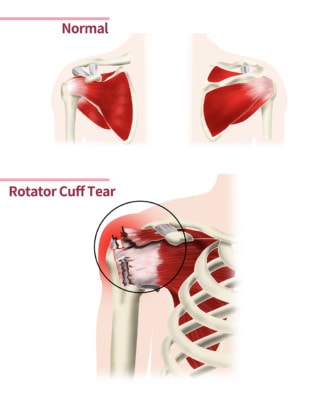Rotator Cuff Surgery Results: Only 1/2 of Athletes Return to Play!
Throwing and other athletes tear their rotator cuff all the time, and you would expect that modern orthopedic surgery would have a great answer for these highly active patients. However, a recent study shows rather poor rotator cuff surgery results with professional and competitive athletes. In fact, less than half returned to the same level of play after surgery. Yikes!
The Problems with Rotator Cuff Surgery

Chu KyungMin/Shutterstock
The rotator cuff supports the shoulder joint. It’s a compact series of muscles and tendons that keep the ball and socket of the joint nice and stable. Rotator cuffs can tear, both in athletes and even through normal wear and tear as we age. When it tears, surgeons love to look inside the shoulder and sew it up, but perhaps the biggest problem with this is the fact that just because a patient shows a rotator cuff tear on their MRI doesn’t mean this is the true source of the patient’s pain.
The truth is, after surgery. many patients never recover their full range of motion, and the pain continues. It would seem obvious that if you have shoulder pain in conjunction with a rotator cuff tear, the tear must be causing the pain, but it’s not that simple. Before we get into the recent study on athletes and rotator cuff tears, I’ve covered many studies on this blog over the years that show no connection between the rotator cuff tear or its severity and the patient’s shoulder pain. Click on the link in the prior paragraph to access these studies, but here is a brief overview:
- The conclusions of one study force us to ask the question, If surgeons are stitching up rotator cuff tears to address pain, but the tear isn’t the true source of the pain, why surgery? The study’s conclusion: Pain and function in the shoulder isn’t “fixed” by a rotator cuff surgery!
- A study out of Japan concluded that the shoulder pain was due to inflammation in the joint, not the tear. The study found that the more interleukin 8 (IL-8), an inflammatory marker, there was in the joint fluid, the more inflammation, and, hence, pain, was present. There was actually less pain in the larger rotator cuffs.
- Another study stated that even in full-thickness rotator cuff tears, patients may show no symptoms. So pain shouldn’t automatically be associated with a rotator cuff tear. This study concluded that even if there is pain due to the rotator cuff tear, in most cases physical therapy should be able to address it.
- Severity of the rotator cuff tear, according to another study, has nothing to do with pain level. In fact, in this study, it was comorbidities, and even education and race, that were associated with the level of pain.
- Just this year, a study stated, “It is becoming clear that symptoms of rotator cuff tears do not correlate with disease severity.” The results showed that the patient’s mental health impacted pain level, and, additionally, it showed no association with full-thickness rotator cuff tears.
It’s clear to see now why rotator cuff tears and shoulder pain aren’t an obvious or given connection. Even in athletes whose pain may have begun in conjunction with the rotator cuff tear—it could be the inflammation, not the tear, for example, causing the pain. It’s also clear to see why for many types of rotator cuff tears (even the full-thickness ones) surgery may not be any better than no surgery, and who wants to undergo invasive surgery for no reason? Additionally, in 6 in 10 patients with large rotator cuff tears, retears occur following surgery and rotator cuff tears don’t heal following surgery in 1 in 3 patients over age 60.
Now let’s look at the new study.
The New Research Showing That Rotator Cuff Surgery Results Are Awful for Athletes
The new research looked at 25 studies that involved the surgical repair of a rotator cuff tear in athletes where the follow-up was at least two years. There were 286 competitive or professional athletes and 349 recreational athletes. While rotator cuff surgery results were manifested in a high level of return to play for recreational athletes, the ability of the professional athletes to return to play was very poor. Of the professional and competitive athletes, only 49.9% returned to the same level of play! Ouch!
The upshot? Why is this happening? As you can see above, while we’d all like to believe that shoulder rotator cuff surgery is effective, the research on rotator cuff surgery results is not great. Having less than half of the patients return to the same level of play they were at before their injury and surgery is awful, which makes me wonder why high-level athletes are still routinely getting this surgery.

NOTE: This blog post provides general information to help the reader better understand regenerative medicine, musculoskeletal health, and related subjects. All content provided in this blog, website, or any linked materials, including text, graphics, images, patient profiles, outcomes, and information, are not intended and should not be considered or used as a substitute for medical advice, diagnosis, or treatment. Please always consult with a professional and certified healthcare provider to discuss if a treatment is right for you.
